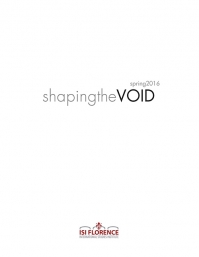
Anno/Year 2016
60 pagine/pages
50 illustrazioni/illustrations.
21x27 cm.
ISBN 978-88-99695-23-1
€12.00
Condividi la scheda di questo libro

 Tweet
Tweet
1_ SHAPING THE VOID_ SPRING 2016
For an architecture student, the opportunity to travel, meet peers from other countries who speak different languages and collaborate with them on design topics is a truly formative experience.
In the first week of February of 2016, the Architecture Program of the International Studies Institute (also known as ISI Florence) organized the fourth Spring Semester collabora-tive design workshop with the Department of Heritage and Architecture from TU Delft. On this occasion, students and faculty from DidA (Dipartimento di Architettura - Università degli Studi di Firenze) joined the workshop for the first time.
The Spring 2016 iteration of the workshop was titled:
Shaping the Void. Ideas and proposals for the urban retraining of Piazza del Carmine.
The students (who worked for one week mixed in groups of five) came from the following institutions:
15 from the Marywood University School of Architecture, under the guidance of Prof. Franco Pisani; 10 from TU Delft, under the guidance of professors Dr. MarieTherese van Thoor and Ir. Wouter Willers; 19 from the Laboratorio di Progettazione III of the DiDA led by Prof. Stefano Lambardi Kindly assisted by Arch. Stefano Corazzini, Arch. Giulia Giuntini, Arch. Simone Barbi, Arch. Alberto Becherini and Arch. Andrea Borghi, faculties from these three schools worked with the students to develop nine different designs for a new layout of the Piazza del Carmine. During the workshop, students had the opportunity to visit this site and other piazzas of “Firenze”. Also, every day at 6.00 pm they attended a lecture by the faculties involved.
During the week, each group approached the topic and the site from different points of view with a constructive spirit and passion. In doing so, they developed not only a pro-posal, but also – and more importantly – an awareness of the potential of design in urban contexts.
The proposals differred: sometimes extreme, sometimes ingenuous, but always genuine and free of prejudices. As such, they offer an interesting range of possibilities to give new life to the Piazza del Carmine.
Although just a small contribution, this booklet – whose layout must be credited to Arch. Simone Barbi – attests to the work done during our week-long workshop. We hope readers will appreciate this collection of the contributions from the students and the professors in-volved.
